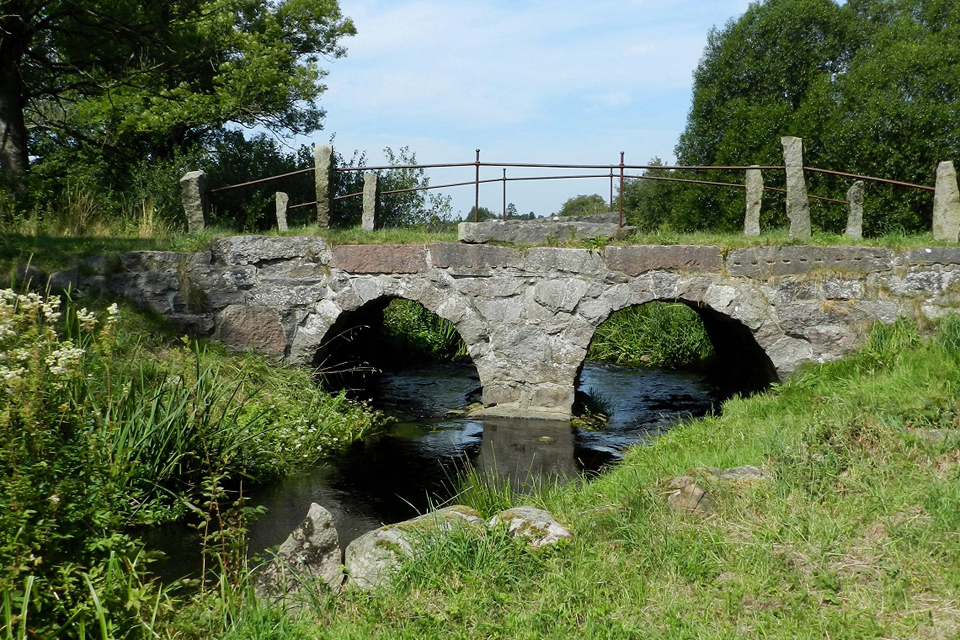The Power of the Harp is a medieval ballad attested in a Danish, Swedish, Norwegian and Icelandic. It tells the story of a frightful fall of fair maiden from a stumbling palfrey and into a river.
The Power of the Harp is one of the more well-known Danish Medieval Ballads of which 539 have been preserved; some in remarkable old manuscripts from the 16th century or even earlier.
In the ballad, The Power of the Harp, a bridegroom asks his betrothed why she is so sorrowful. Is it because he has not presented her with enough splendid gifts? Or because he is not wealthy or powerful enough? At last she answers and tells him she has had a foreboding that she will fall from the bridge and into the river on her way to her bedding at his house. In some variants, we are told, the this was also the fate of her sisters. Her betrothed promises to build a broad, strong bridge over the river, shod her horse with golden shoes and that he and his men will protect her. Nevertheless and despite these precautions, the men are lured out hunting, while the palfrey with the maiden stumbles over the bridge, and she tumbles into the river. Or – in another version – they try to catch her but cannot hold their grip. However, now the man has his golden harp brought to him. Playing beautifully, the “merman”, “troll” or water spirit is forced to return her. In variants, she is followed by her sisters, while in the Icelandic version, only her corpse is returned.
This particular ballad is often seen as the archetypal supernatural ballad (tryllevise), a particular subgenre, which blends natural and supernatural worlds. However, as with all ballads it may be read and understood in a number of different ways. Thus it is obvious that the story is about movements between both genders (male-female) and worlds (land and water) as well as across border-lines (bridges) between these worlds.
Saddles, palfrey and golden horse-shoes.
 However, a third “bridge” which the fair maiden has to cross is obviously also stretched out between materiality and love.
However, a third “bridge” which the fair maiden has to cross is obviously also stretched out between materiality and love.
The song begins with the newly-wed maiden sitting in her bower weeping, while her new husband is either playing in the courtyard with his friends or playing dice with her in her bower. The wedding has just taken place at her parents house, and soon the couple will be at the centre of a merry procession to his home. “Tell me, my hearts own dear, where fore you grieve”? he asks her. And then he continues: “do you grieve for saddle and steed?” – in some versions the steed is said to be black and white. As to which she answers no: she does not grieve for that; nor does she grieve for (lack of) gold or land or the fact that she is more noble. She even tells him in some versions that she has chosen him herself and not as prodded by her parents. Versions vary, but the core of the text is his fear of lack in material wealth and staus. No, she tells him, she grieves for her fair gold hair, “which in the blue waves shall be stained to-day”, being the river in which both her sisters died just after their wedding. It does not stretch the imagination much to hear that she grieves for her maidenhood, which she will loose when she is bedded tonight at her future home. It is definitely significant that in yet another version of the ballad, she ends up sleeping each night in his arms.
The point to be made here is however, that she does not grieve for that, which he is afraid it is all about – the quality of her saddle, the horse she will ride, the wealth and honour he possesses etc.
In order to calm her down, he promises that she will be accompanied by twelve men ahead and twelve men behind and that her horse will be shod properly with golden shoes. Unfortunately, neither of these promises is fulfilled. In a Swedish version, the men are lured away by a deer with golden horns and the maid is left to cross the bridge alone. In a Danish version, they try to catch hold of her saddle, but are unsuccessful. At which point, of course, her palfrey stumbles because the shodding was not perfect (it lacks a nail); into the swift and raging stream she falls. It now takes for her husband to play his golden harp. By letting the music loose, the merman lets her and her sisters go free. In the Danish version she end up on his steed and not her own palfrey!
The morale? Well, as one of the qualities of a medieval ballad is the fact that it is left to the listeners to decide on their own, each is free to pick his or her own choice.
However, to this reader, the song is not only about genders and sex; nor is it just about natural and super-natural worlds. Perhaps it is also a song, which was composed and performed at a time when the lust for materiality was seen to over-power the dream of love.
Rather romantic…
Dancing Songs
As is well-known, the ballads were obviously meant as songs to be danced by. Unfortunately the music is – apart from a few fragments – lost. However, in the 19th century folklorists went around the Danish countryside and recorded the singing of the old songs. Whether or not a an fine example of an invention of an old tradition, it may to some extent have sounded somewhat like this: The Sound of Medieval Danish Ballads recorded in the 19th century
 http://www.medievalhistories.com/wp-content/uploads/Gejlaa-bridge-in-Denmark-500x333.jpg 500w,
http://www.medievalhistories.com/wp-content/uploads/Gejlaa-bridge-in-Denmark-500x333.jpg 500w, 















Pentru a putea adăuga comentarii trebuie să fii membru al altmarius !
Alătură-te reţelei altmarius